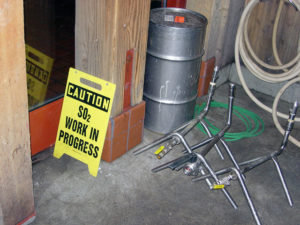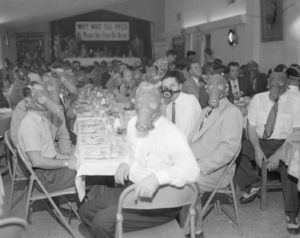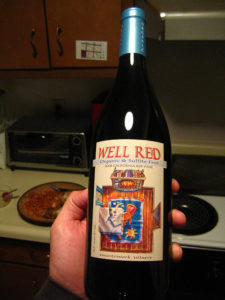The use of sulfites in winemaking, while extremely common, has come under scrutiny in recent years for a variety of reasons (sometimes legitimate and sometimes ridiculous), and alternatives to the practice have been and are currently under study all over the world. Some examples of alternatives to SO2 that have been studied include (but are

Photo courtesy Flickr user Adam Engelhart
certainly not limited to); high pressure treatment, natural plant extracts, resveratrol, pulsed electric fields, ultrasound, other chemical treatments, and ozone.
A new study, published in June in the Australian Journal of Grape and Wine Research, aimed to add to the growing literature of using ozone as an alternative to SO2 in wine, specifically to evaluate how ozone treatment of grapes post-harvest affects microbial populations, as well as fermentation kinetics, chemical composition of both grapes and wines, and the sensory characteristics of the finished wine.
Brief Methods
Petit Verdot grapes were harvested from the Falesco Winery in Montecchio, Italy and were divided into two groups for 500kg each for treatment: an ozone treatment and a control (SO2) treatment.
Grape bunches were harvested by hand and then placed in perforated boxes that are normally used for dehydrating grapes. The boxes of grapes were then stored in a cold room overnight at 4oC, 70% relative humidity, and “normal” ventilation via fans.
For the ozone treatment, grapes were fumigated with ozone (20g/h with 6% w/w of ozone) at a flow rate of 150 normal liter/h in a 9m3 cold room. Wine was made from the grapes the next day. For the ozone treatment, all winemaking equipment was treated with ozonated water prior to use. No SO2 was added to the wine undergoing the ozone treatment.
For the control treatment, grapes were kept under the same conditions, except no ozone

Photo courtesy [Public domain], via Wikimedia Commons
All wines were aged in barrels “with fine less” for 4 months.
The following were measured and analyzed for the grapes, must, and wines: ethanol, reducing sugars, pH, titratable acidity, volatile acidity, total SO2, free SO2, phenolic compounds, anthocyanins, color, and tannin.
The number of bacteria and yeasts on grapes from both treatments were measured and analyzed after treatment.
Sensory analysis was performed by a panel of mostly winemakers.
Selected Results
- Ozone treatment did not affect sugars, titratable acidity, or pH of grapes.
- Ozone treatment significantly increased anthocyanins and skin tannins.
- In ozone treated grapes, anthocyanin concentrations increased 16% compared with the levels prior to treatment.
- In the control grapes, anthocyanin concentrations increased 6% compared with levels prior to treatment.
- Ozone treatment thus provided greater extraction of anthocyanin than the control (SO2) treatment. Additionally, some of the extraction may have been a result of the cold storage treatment, since anthocyanin levels also increased in the control group.
- It took between 5 and 7 days for anthocyanins to be extracted in the ozone treatment musts, while it took 11 to 16 days for this extraction to occur in the control musts (see below for more on alcoholic fermentation results).
- In ozone treated grapes, skin tannins increased 14%.
- In control grapes, skin tannins remained unchanged.
- There was no effect on seed tannins (both treatment showed similar levels).
- Alcoholic fermentation kinetics were significantly different between treatments.
- In the ozone treatment, sugars decreased from 240g/L to 1.3g/L in 10 days.
- In the control treatment, fermentation finally started after 3 days, wasn’t finished after 10 days, and needed an additional 6 days to bring the sugars below 2g/L.
- Despite being inoculated with a large amount of commercial yeasts in both treatments, the control treatment was still slow to start and slow to get through alcoholic fermentation compared with the ozone treatment.
- Final ethanol concentrations for the ozone treatment was 13.9% and was 14.5% for the control.
- In the ozone treatment, significant reductions in populations were seen for acetic acid bacteria, lactic bacteria, Hanseniaspora uvarum yeasts, Pichia membranifaciens yeast, and S. cerevisiae yeasts.
- Titratable acidity was significantly higher after the ozone treatment compared with the control.
- pH was lower (but NOT significantly different) in the wines produced after ozone treatment, while pH levels in the grapes after both treatments were the same.
- Total and free SO2 levels were higher in the control wines compared with the ozone treatment (which was expected).
- Volatile acidity levels were similar between treatments.
- The ozone treatment resulted in wines that were more intense with red and purple colors.
- Further sensory analysis showed:
- Ozone treatment wines scored higher for fruitiness, particularly small red fruits and blackberry.
- Ozone treatment wines also scored higher for cherry liqueur, nail varnish, and spices.
- No significant differences in the overall taste of both treatment wines were noted.
- Ozone treatment wines scored higher for overall quality compared to control (SO2) wines, particularly regarding aroma.
- One final, random tidbit: for the overnight ozone treatment, energy consumption was less than 1kWh.
Conclusions
Overall, the results of this study seem to suggest that ozone treatment of grapes after harvest may be a viable alternative to using SO2 in winemaking. Based on these results, it may also suggest that ozone treatment could be better not only for reducing the populations of microbial organisms, but may improve the overall taste and quality of the finished wines.
A few questions that could come up are:
- Can this be done on a larger scale? In this study, clusters were hand harvested and placed in boxes for treatment. How much time and manhours would this take on a larger scale?
- How does the ozone treatment affect wine aging? This study aged the wines for 4 months, but what about longer than that? Does the ozone treatment still perform better than the control SO2 treatment over a longer period?
- How does the ozone treatment affect other phenolic or aromatic compounds in the wine? This study only really looked at anthocyanins and tannins, though as we all know, there is a lot more to wine than that. How does the ozone treatment affect other compounds?
- Does the ozone treatment affect other grapes similarly? Or do some grapes react much differently to the treatment? How about the same grape but from different regions?
- Other questions you might have??

Photo courtesy Flickr user rick
From these results, it appears that ozone treatment of grapes post-harvest may be a viable alternative (and may, in fact, be even better) to using SO2 in winemaking, though certainly more work may need to be done before it can be applied on a commercial scale.
Source:

6 comments for “The Use of Ozone as an Alternative to Sulfites in Winemaking”